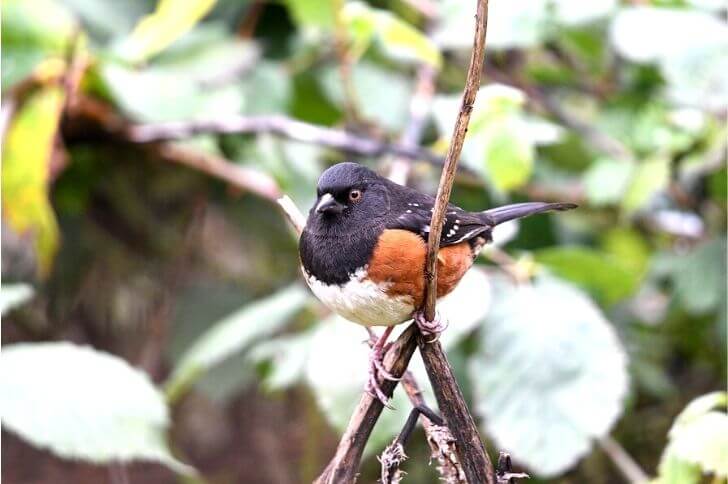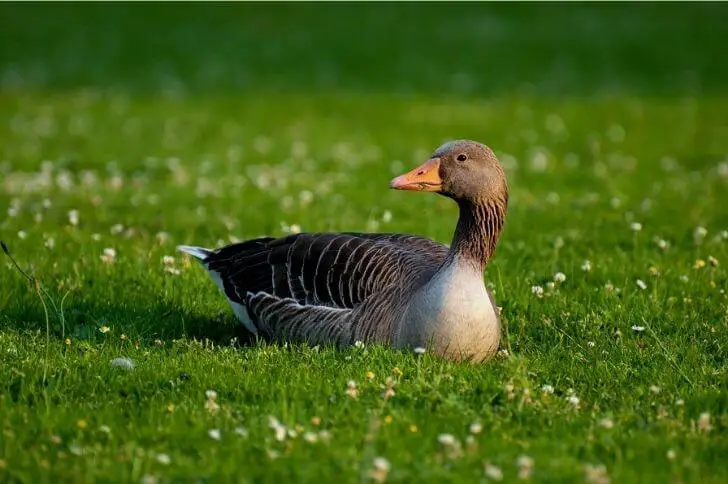As the seasons change in the northeast, so do the birds. In the spring, songbirds like robins and orioles can be heard singing as they fly from tree to tree in search of food. As summer approaches, these same birds can be seen building nests and raising their young.
In the fall, many of the songbirds migrate south for the winter. However, there are still plenty of birds to be seen in the northeast during this season. Waterfowl like ducks and geese can often be found swimming in ponds and lakes. And raptors like hawks and eagles can be seen soaring through the sky in search of their next meal.
As winter approaches, many of the birds that call the northeast home begin to migrate south for the winter. However, there are still some hardy souls that brave the cold weather. Below we’ll look at the birds of the northeast that you can see in different seasons.
List of Northeast Birds
1. Blue Jays
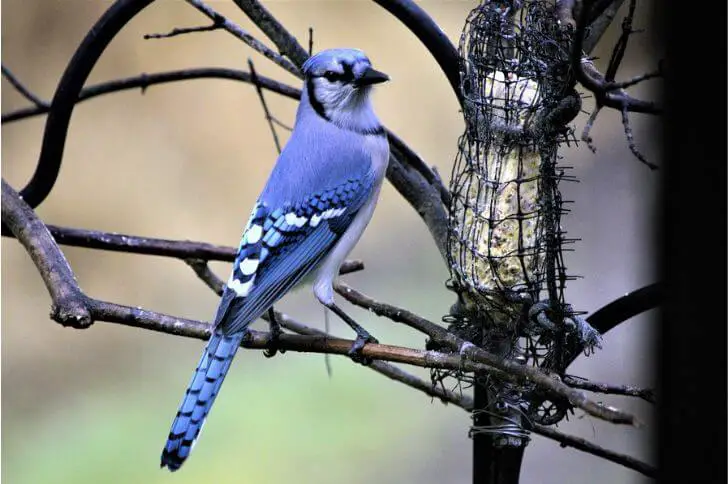
Blue jays are one of the most common birds of Northeast America. They belong to the crow family.
Identification:
They are known for their bright blue plumage on their head and backs. Both sexes spot a bold black necklace and whitish underparts. Note their short bill and long tail. Blue jays are about 9.8-11.8 inches with a wingspan of up to 16 inches. An adult has a body mass of 2.5-3.5 oz.
Other facts:
Blue jays are known for their soft churrs, whines and clicks. They also have a loud jeer sound. They are found in the Northeast all year round, meaning no matter the season you can attract blue jays to your yard.
These birds are intelligent and resourceful. Blue jays will also work together to scare away predators from their nests.
These beautiful birds play an important role in today’s ecosystem. They help to spread seeds and pollinate flowers. The blue jay is a cherished part of North American wildlife.
2. Purple Finch

Wintering in the Northeast, Purple finches are a type of small songbird that are easily identifiable because of their unique plumage.
Identification:
Though they are not the only bird with this plumage, they are one of the most well-known. The coloring of the purple finch is largely due to the pigments in their diet. The purple finch male spots a reddish head and breast with brownish wings and a whitish belly.
Juvenile males and females are brown and heavily streaked. Adults are about 4.7-6.3 inches long with a span of up to 10.2 inches. Both sexes have strong canonical bills. Note the slightly forked tail.
Other facts:
The purple finch breeds mostly in forested areas but can also be found near edges or clearings. These birds of the Northeast are seed eaters but will also consume berries and insects. During their nesting season, the female purple finch will lay 2-7 eggs that are incubated for two weeks.
3. House Sparrow

With a round head and a chunky body, the house sparrow is a Northeastern bird that is a resident breeder. They are common backyard birds of the northeast and here’s how you can identify them.
Identification:
The male features a gray cap, a rufous neck, a heavily streaked brown back, and grayish below. Notice the black throat and eye mask. The female is dull brown with streaks on her back. Her underparts are gray-brown.
House sparrows are relatively small birds around 5 inches in length. They spot black bibs.
Other facts:
They are very adaptable birds and are able to live in close proximity to humans. They build their nests in trees, bushes, or holes in buildings. House sparrows eat insects, seeds, and berries.
In Northeastern United States, these small birds start breeding in early spring. They can raise 1 to 4 broods each season, depending on the availability of food.
4. White-Crowned Sparrow

The white crowned sparrow are beautiful winter birds of the Northeast. They are closely related to the house sparrow above.
Identification:
The adult bird has a white crown with black streaks, and the rest of its body is grayish-brown. Note, like the house sparrow, its back is brown with black streaks. Juveniles have a black and white crown. The white crowned sparrow is a relatively small bird, measuring only about 6 inches in length.
Other facts:
The white crowned sparrow is found in open woodlands and scrublands across the Northeast. It typically nests in trees or shrubs, but can also build its nest on the ground. The female bird lays 3-7 eggs per clutch, and incubates them for about 12 days before they hatch.
Each breeding season, depending on food availability, a pair can raise 2-3 clutches. The diet of the white crowned sparrow consists mainly of insects and seeds. In the summer months, the bird will eat more insects, while in the winter it will eat more seeds. Nest boxes are a great way to attract them to your backyard.
Related Read: Check out interesting Birds of Cape Cod
5. Brown-Headed Cowbird
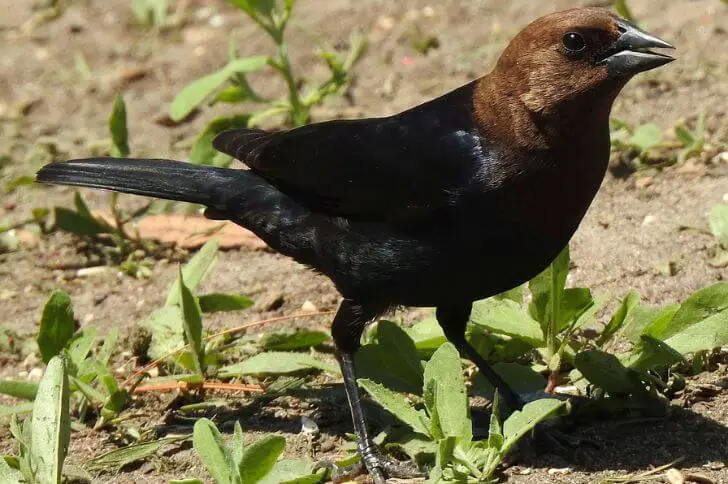
When can you see brown-headed cowbirds in Northeast America? During their breeding season which starts in early April through July.
Identification:
I think they are one of the easiest birds to identify on this list. Males are black with a brown head while females are all gray. Both sexes spot dark eyes and canonical bills. Also note, brown-headed cowbird males are slightly larger than females.
Other facts:
The brown-headed cowbird is a parasitic bird that lays its eggs in the nests of other birds. The cowbird chicks hatch first and are fed by the host parents at the expense of their own chicks. This behavior has led to the decline of many songbird populations.
Brown-headed cowbirds are found in open habitats such as fields, prairies, and farmland. Also, during the breeding season, brown-headed cowbirds form flocks and follow around herds of cows or other animals. When a cow or other animal defecates, the cowbirds eat the insects that are attracted to the dung.
6. House Finch

The house finch is a small songbird that is native to North America. In the Northeast, they can be found all year round. These cheerful little birds are a common sight at bird feeders and in backyards across the continent.
Identify birds:
House finches are easily identified by their red heads and breasts, which make them a favorite among bird lovers. Like the purple finches females, female house finches are dull. They are gray overall with dark markings. And like other birds in their family, they have canonical bills.
Other facts:
Despite their popularity, house finches are actually quite secretive birds. They nest in hidden locations and are often only seen when they are feeding on the ground. However, these secretive habits do not make them any less interesting to watch.
If you’re lucky enough to spot a house finch, you’ll be treated to a beautiful songbird with a personality all its own.
7. Black-Capped Chickadees

Black capped chickadees are small songbirds that are found in wooded areas across the Northeast US. They are found all-year around this region.
Identification:
These birds are easily recognizable by their black heads and white cheeks. Their backs are gray and whitish underneath. Bills are really small. These birds in Northeast are smaller than the house sparrows above.
Interesting facts:
Chickadees are known for their cheerful songs, which they often sing while gathering food. These little birds are very adaptable and can often be seen in urban areas, where they will come to bird feeders.
Black capped chickadees are not afraid of humans and will often land on people’s shoulders or heads. These birds play an important role in the ecosystem by eating insects and dispersing seeds.
8. American Robin

Found all-year round in Northeast America, the American robin is a popular songbird that is common in most backyards.
Identification:
These birds are easily recognizable by their rusty breasts and cheery song. The rest of their body is gray and a black head. Both sexes have a white eyering and yellow bill. Note the white undertail, long tail and triangular wings. Immature American robins are duller.
Other facts:
American robins are found in a variety of habitats, including woodlands, gardens, and parks. They typically eat insects and berries, but will also consume other small animals if given the opportunity.
These birds play an important role in the ecosystem by helping to control insect populations. In addition to their ecological benefits, American robins are also popular symbols of springtime and hope.
9. Northern Cardinal
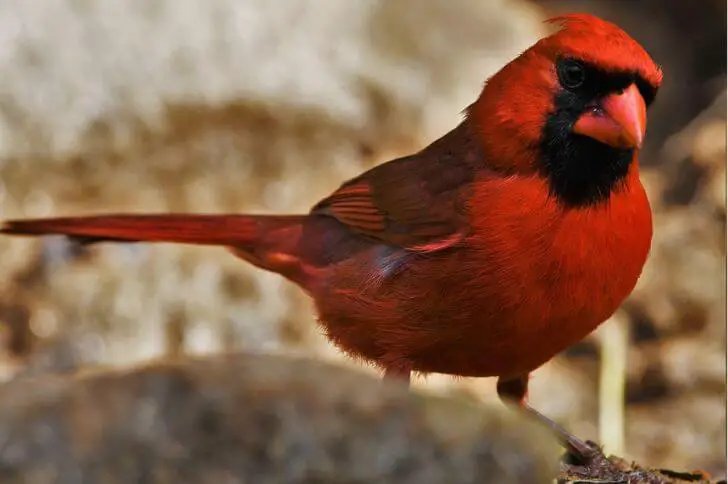
Probably one of the most common birds of the Northeast, cardinals are not only beautiful but an important part of this region’s wildlife.
Identification:
The male cardinal is especially vibrant. He is easily recognizable by his red plumage and black mask. The female cardinal is less brightly colored, with a grayish-brown body. Note here red-tipped wings and crest. Both sexes have a red bill and beady eyes.
Other facts:
Cardinals are not only pretty to look at, but they are also good singers. Their song consists of a series of short whistles, followed by a trill. Cardinals are social birds and often form small flocks. They are mostly active during the day, but they will also sing at night. Cardinals are not migratory birds, but they do move around in search of food and mates.
10. Red-Winged Blackbirds
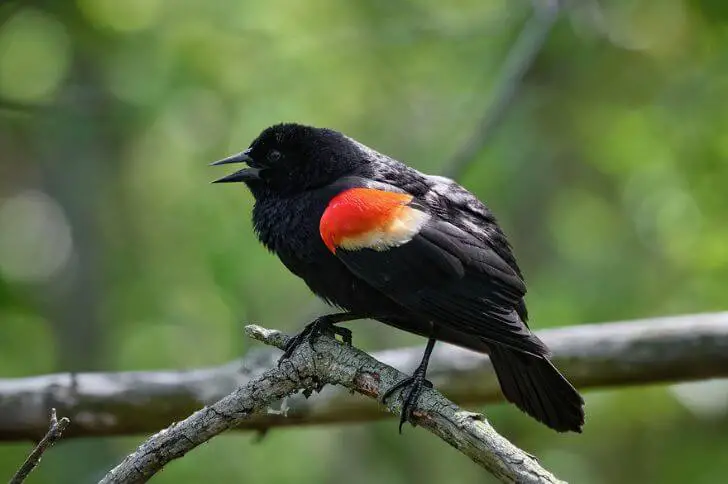
The Red-Winged Blackbird is a species of true blackbird. These blackbirds of Northeast are easy to identify.
Identification:
The adult male has glossy black feathers and red shoulder patches. Note the yellowish border on the red patches. Females also spot broad shoulders and are heavily streaked. They have a wingspan that varies between 12.5-15.8 inches.
Other facts:
It is found in marshes and wetlands across Northeastern states. The female Red-Winged Blackbird builds her nest on the ground, hidden among tall grasses. The female incubates the eggs and cares for the young birds.
The Red-Winged Blackbird is a social bird and often seen in large flocks. They have a loud song. The males sing to proclaim their territory and attract mates. These birds are also found in central and South America.
11. Dark-Eyed Juncos
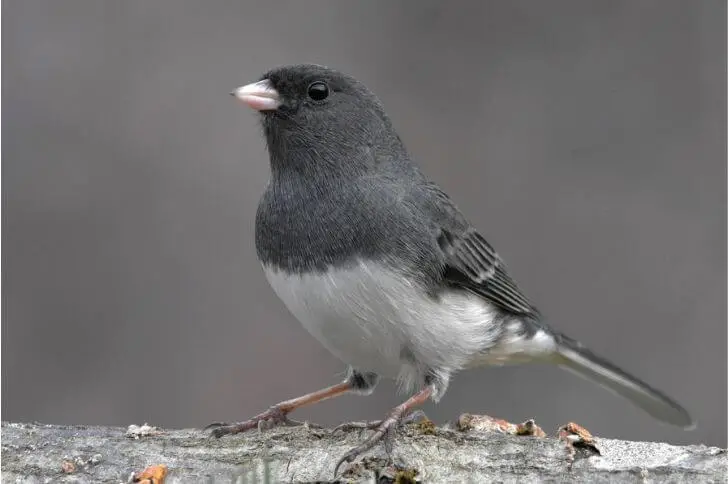
Dark-eyed juncos are a small sparrow-like bird that are endemic to some states in the Northeast.
Identification:
The adult junco has a gray body and a white belly. Note the small pinkish bill and beady eyes. An adult can measure up to 6.3 inches in length with a span of 9.8 inches.
Other facts:
These birds are usually seen in wooded areas near streams or ponds. During the winter months, the dark eyed junco will often come to backyard bird feeders in search of food.
They eat mostly seeds and insects. The dark eyed junco is a member of the same family as the house finch and American goldfinch.
12. Bald Eagle

What are the birds of prey of the northeast? The Bald Eagle is a majestic bird of prey that breeds in this region. It is also a winter visitor in some states in Northeast US
Identification:
These birds are easily recognizable with their distinctive white head and tail. The rest of their body is black and they have a yellow curved bill.
When it comes to wingspan, these Northeastern birds boast of a 80 inch span making them one of the most powerful fliers.
Other facts:
They primarily eat fish, but will also hunt small mammals and birds. They mate for life and build their nests in tall trees near water sources. The female eagle lays 1-3 eggs which hatch after about 35 days. Both parents help to care for the young eagles until they are old enough to fly on their own, typically at around 12 weeks of age.
Today, the Bald Eagle is no longer considered an endangered species thanks to conservation efforts. These stunning birds continue to awe onlookers with their grace and strength.
13. American Crow

Crows are one of the most intelligent bird species in Northeast America. They are also one of the most adaptable, able to live in a wide variety of habitats and climates.
Identification:
It is an all-black bird with shiny feathers. The adult measures up to 20 inches in length, has a body mass of about 20 oz and a span of up to 39.4 inches.
Other facts:
Though they are often considered pests, crows play an important role in the ecosystem. They are known to eat small mammals, reptiles, and other birds, help disperse seeds, and control insect populations.
Crows are interesting creatures that have been studied by scientists for years. Their unique behavior and abilities make them one of the most fascinating bird species in the Northeast.
14. Gray Catbird

Do you know any black-headed gray birds? Gray catbirds are interesting birds in the North East.
Identification:
Its named after its plumage, gray. But, why call it a catbird? This bird gets its unique name from its unique “meow” like calls. These medium-sized birds also spot a small black cap and long tail. Both sexes spot similar plumage.
Other facts:
The gray catbird is a member of the mimid family, which includes the mockingbirds and thrashers. It is a shy bird that is often seen alone or in pairs. This bird is found in the Northeast during its breeding period, spring and summer.
It feeds on insects, berries, and fruits. The gray catbird nests in trees and shrubs. The female gray catbird lays 4-5 eggs which she then incubates for 12-14 days. Gray catbird fledglings leave the nest at about 18 days old.
15. Red-Breasted Nuthatch

Ever seen a bird without a neck? The red breasted nuthatch is a small bird with a big personality.
Identification:
Measuring in at only 5-6 inches, this feisty little guy is not afraid to take on much larger birds. The adult spots a rusty belly and blue-gray upperparts. Note the black and white striped head. red-breasted nuthatches also have a white throat and a really thick neck that blends into the rest of the body, making them appear as if they don’t have necks.
Other facts:
The nuthatch gets its name from its habit of wedging nuts into cracks in bark and then hammering them open with its bill.
In addition to being one of the few birds that can walk upside down, the red breasted nuthatch is also known for its distinctive call which sounds like it’s saying “yank yank yank”.
In the Northeast, they are found all year round. Although they are not considered endangered, the red breasted nuthatch population has been declining in recent years due to habitat loss. So if you’re lucky enough to spot one of these little guys, be sure to give them a wide berth and admire from afar.
16. White-Breasted Nuthatch

The white-breasted nuthatch is a small, acrobatic bird that is found all-year in the Northeast. They are closely related to the red-breasted nuthatches above.
Identification:
With a distinctive black cap and white breast, these birds have distinctive features that make identification easy. The upperparts are gray-blue. It is the largest bird in the nuthatch family, around 5.5 inches long. And, like the red-breasted nuthatch, its neck is hardly visible.
Interesting facts:
These birds favor woodland edges and mature forests, where they feed on insects and nuts. Nuthatches are known for their ability to walk down trees head-first, and for their loud, nasal calls.
These little birds are fun to watch as they scurry up, down, and around tree trunks and branches in search of food. The white-breasted nuthatch is an important part of the forest ecosystem, helping to control insect populations.
17. Indigo Bunting

What are the blue birds of Northeast US? Indigo buntings are small blue seeding eating birds that are found during summer months.
Identification:
It is a member of the genus Passerina, which contains all the buntings. The adult male has bright blue plumage and black plumage around its bill. The adult female is brownish with streaked underparts. Indigo bunting spot canonical bills that come in handy when foraging for seeds.
Other facts:
The breeding habitat is open woodlands with bushes. The nest is built in a tree or bush and consists of a cup of grass, leaves, bark strips and rootlets, lined with hair.
The indigo bunting is a shy bird that usually stays hidden in trees and bushes. However, during the breeding season, the male can be seen singing from exposed perches to attract mates. The song is a series of clear notes followed by a trill. This bird can also be seen flying high above treetops in search of food.
18. House Wren

Another group of birds of the northeast that have made this region their breeding ground are the house wrens. Known for their long calls, here is what to look for to identify them.
Identification:
It is a member of the wren family, which includes over 60 species of birds. The house wren is one of the most common backyard birds during spring and summer months when these birds lay eggs and raise their young.
The adult bird is brown with barrings on its wings. Tail is short and like nuthatches, the neck is almost invisible. The bird is about 4.3 to 5.1 inches long.
Interesting facts:
Despite its small size, the house wren is an important part of the ecosystem. Its nest-building behavior helps to disperse seeds and create new habitat for other animals.
The house wren is a welcome addition to any backyard birding list. Its curious nature and cheerful song make it a perfect bird for beginners to watch and learn from.
19. Pileated Woodpeckers

Pileated woodpeckers are one of the largest and most distinctive woodpeckers in the Northeast US. Like other woodpeckers, they have distinctive plumage and habits that are interesting for bird lovers to watch and listen to.
Identify birds:
They are black with white stripes that run from their head to their sides. Note the flaming red crest. Also, they are larger than other birds in their family, about 15.8-19.3 inches. Juveniles are duller.
Other facts:
These birds are very shy and seldom seen, but their loud calls can often be heard in the woods. Pileated woodpeckers live in forests and woodlands across some Northeastern states. They prefer mature forests with large trees that have plenty of deadwood for them to peck on.
These birds use their powerful beaks to drill holes in trees in search of food. Their diet consists mostly of insects, but they will also eat berries and nuts.
Pileated woodpeckers play an important role in forest ecosystems. By drilling holes in deadwood, they create homes for other animals such as bats, owls, and small mammals.
20. American Black Duck
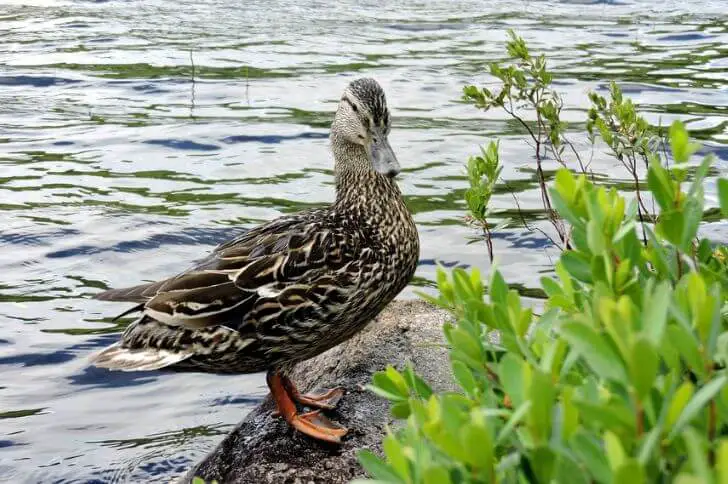
Know any Northeast water birds? The American black duck is a species of waterbird that you can find around ponds and marshes in parts of Northeast America. It is a member of the Anatidae family, which includes ducks, geese, and swans.
Identification:
The black duck is sexually dimorphic, meaning that males and females look different. The male black duck has a dark brown body with yellow bill and brownish neck. The female black duck has a mottled brown body with an olive bill. Also the male duck is heavier than the female.
Other facts:
The black duck is found in wooded wetlands. It is an omnivorous bird, meaning that it eats both plants and animals. The diet of the black duck consists of dragonflies, mollusks, beetles, plant tubers, and even fish. Juveniles are mostly fed on proteins to enable fast growth.
21. Whooping Crane

One of the rarest birds of the Northeast are the whooping crane. Large and majestic, this bird is found in the State of Wisconsin during summer. The bird is endangered and you can identify it:
Identification:
The whooping crane, one of the tallest Northeast American birds, has a wingspan of up to 7 feet and stands nearly 5 feet tall. The adult whooping crane is all white with a red cap on its head. The juvenile has grayish-brown plumage with some white on its wings.
Other facts:
Whooping cranes mate for life and nests are built in marshes or wet meadows. These magnificent birds were on the brink of extinction in the 1940s, but thanks to conservation efforts, their numbers have increased today. Whooping cranes spend their winters in the Gulf Coast of Texas and their summers in Wisconsin and other Northeast states.
Final Thoughts:
In conclusion, the northeastern United States is home to a variety of birds, from the common crow to the more rare bald eagle. Bird watching is a popular hobby in this region, and there are many different ways to get started. Whether you’re looking to identify different species or just enjoy the beauty of nature, bird watching is a great way to spend some time outdoors.
Sources:
https://en.wikipedia.org/wiki/Whooping_crane
https://www.audubon.org/field-guide/bird/brown-headed-cowbird
Hi fellow bird watcher. Welcome to our small corner of the world. At the spanishbirdguides.com our mission is to share with other bird watchers the things we love about birds, where to go bird watching within the United States, and more. I’d also love to hear from you. Feel free to contact me about your bird watching escapades, share videos, photos and more.
